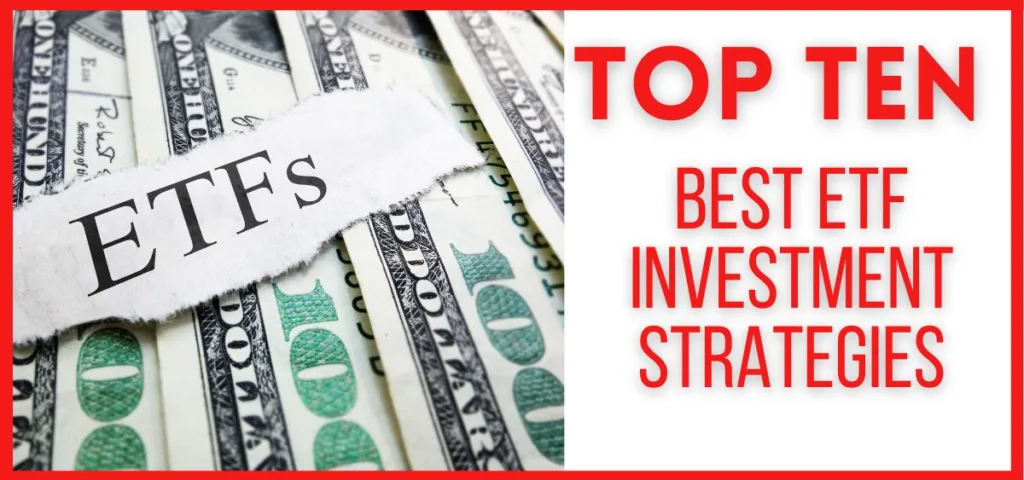In today’s dynamic financial landscape, choosing the right investment strategies is crucial to securing your financial future. Exchange-Traded Funds (ETFs) have become increasingly popular due to their flexibility and diversification benefits. To help you navigate this exciting investment opportunity, we’ve compiled a detailed guide to the Top 10 Best ETF Investment Strategies.
Top 10 Best ETF Investment Strategies
Exchange-traded funds (ETFs) are a popular investment vehicle for investors of all experience levels. They offer a number of advantages, including low costs, diversification, and liquidity. ETFs can be used to implement a variety of investment strategies, depending on your individual goals and risk tolerance.
Here are 10 of the best ETF investment strategies:
1. Buy-and-hold investing
Meaning: Buy-and-hold investing is a passive investment strategy in which an investor buys stocks or ETFs and holds them for a long period of time, regardless of short-term market fluctuations. Buy-and-hold investors believe that the stock market will trend upward over time, and they are willing to ride out any short-term volatility in order to achieve their long-term investment goals.
Process: To implement a buy-and-hold investing strategy, investors typically select a diversified portfolio of stocks or ETFs and then hold them for a period of 5-10 years or more. Investors should rebalance their portfolios periodically to ensure that they remain aligned with their investment goals and risk tolerance.
Example: An investor who believes in the long-term growth potential of the US stock market could invest in a broad-market ETF such as the SPDR S&P 500 ETF (SPY). The S&P 500 ETF tracks the largest 500 companies in the US stock market, and it has historically returned an average of about 10% per year over the long term.
2. Dollar-cost averaging
Meaning: Dollar-cost averaging is an investment strategy in which an investor invests a fixed amount of money in an asset at regular intervals, regardless of the price. This strategy can help to reduce the overall cost of an investment over time by avoiding the temptation to buy high and sell low.
Process: To implement a dollar-cost averaging strategy, investors first select an asset to invest in and then decide how much money they want to invest each month or quarter. Investors then set up a recurring investment order, so that their investment is automatically purchased at the specified intervals.
Example: An investor who wants to invest in the technology sector could invest $500 per month in an ETF such as the Invesco QQQ Trust (QQQ). The QQQ ETF tracks the Nasdaq 100 Index, which is a basket of the 100 largest non-financial companies listed on the Nasdaq stock exchange.
3. Asset allocation
Meaning: Asset allocation is the process of dividing your investment portfolio among different asset classes, such as stocks, bonds, and cash. Asset allocation is an important part of any investment strategy, as it can help to reduce risk and improve returns.
Process: When determining an asset allocation, investors should consider their individual goals, risk tolerance, and time horizon. For example, a young investor with a long time horizon might choose an asset allocation of 80% stocks and 20% bonds. A retired investor with a shorter time horizon might choose a more conservative asset allocation of 60% stocks and 40% bonds.
Example: A young investor with a long time horizon might choose to invest 80% of their portfolio in the SPDR S&P 500 ETF (SPY) and 20% of their portfolio in the iShares Core US Aggregate Bond ETF (AGG).
4. Sector rotation
Meaning: Sector rotation is an investment strategy in which an investor invests in ETFs that track different sectors of the economy, such as technology, healthcare, and consumer staples. The goal of sector rotation is to overweight sectors that are expected to outperform and underweight sectors that are expected to underperform.
Process: To implement a sector rotation strategy, investors first need to identify the sectors that they believe are poised to outperform the market. Once they have identified these sectors, they can invest in ETFs that track those sectors. Investors should rebalance their portfolios periodically to ensure that their sector allocation remains aligned with their investment goals and risk tolerance.
Example: An investor who believes that the healthcare sector is poised to outperform the market in the coming year could invest in an ETF such as the Health Care Select Sector SPDR Fund (XLV). The XLV ETF tracks a basket of healthcare companies, and it has historically outperformed the S&P 500 Index during periods of economic growth.
5. Swing trading
Meaning: Swing trading is an investment strategy in which an investor buys and sells ETFs over a period of days or weeks. Swing traders typically look for short-term price movements in ETFs, and they attempt to profit from these movements.
Process: To implement a swing trading strategy, investors need to identify ETFs that they believe are poised to move higher or lower in the near term. Once they have identified these ETFs, they can buy them and then sell them when they reach their target price. Swing trading is a more active investment strategy than buy-and-hold investing, and it requires more time and expertise.
Example: A swing trader might buy an ETF that tracks the consumer discretionary sector if they believe that sector is due for a rebound. They might then sell the ETF a few days or weeks later if they believe that the rebound has run its course.
6. Leveraging
Meaning: Leveraging is an investment strategy in which an investor uses borrowed money to amplify the returns of an investment. Leveraged ETFs use financial derivatives and debt to amplify the returns of the underlying index.
Process: Leveraged ETFs are typically available in 2x and 3x versions. A 2x leveraged ETF will amplify the returns of the underlying index by 200%, while a 3x leveraged ETF will amplify the returns of the underlying index by 300%.
Example: An investor who believes that the technology sector is going to have a strong year could invest in a leveraged ETF such as the ProShares UltraPro QQQ ETF (UPRO). This ETF amplifies the returns of the Nasdaq 100 Index by 3x.
Note: Leveraged ETFs can be very risky, and they should only be used by experienced investors.
7. Short-selling
Meaning: Short-selling is an investment strategy in which an investor borrows shares of an ETF and then sells them, with the hope of buying them back at a lower price later and making a profit.
Process: To implement a short-selling strategy, investors first need to identify ETFs that they believe are poised to decline in price. Once they have identified these ETFs, they can borrow shares of the ETFs and then sell them. If the price of the ETFs declines, investors can then buy the shares back at a lower price and return them to the lender, making a profit on the difference.
Example: An investor who believes that the technology sector is due for a pullback could short-sell an ETF such as the Technology Select Sector SPDR Fund (XLK). This would involve borrowing shares of the XLK ETF and selling them, with the hope of buying them back at a lower price later and making a profit.
8. Hedging
Meaning: Hedging is an investment strategy that is used to reduce risk. Hedging can be done by using ETFs that move in the opposite direction of other investments.
Process: To implement a hedging strategy, investors need to identify ETFs that move in the opposite direction of their other investments. Once they have identified these ETFs, they can invest in them to reduce their overall risk.
Example: An investor who is long on a portfolio of technology stocks could hedge their risk by buying an ETF such as the ProShares Short QQQ ETF (SQQQ). This ETF would move in the opposite direction of the technology sector, which could help to offset losses in the investor’s portfolio if the sector declines.
9. Dividend investing
Meaning: Dividend investing is an investment strategy in which an investor invests in ETFs that pay high dividends. This strategy can provide investors with a steady stream of income.
Process: To implement a dividend investing strategy, investors need to identify ETFs that pay high dividends. Once they have identified these ETFs, they can invest in them and then collect the dividends on a regular basis.
Example: An investor who is looking for a steady stream of income could invest in an ETF such as the Vanguard Dividend Appreciation ETF (VIG). This ETF tracks a basket of stocks that have consistently increased their dividends over time.
10. Thematic investing
Meaning: Thematic investing is an investment strategy in which an investor invests in ETFs that track specific themes, such as artificial intelligence, renewable energy, or healthcare. This strategy can be a way to invest in emerging trends and industries.
Process: To implement a thematic investing strategy, investors need to identify ETFs that track themes that they believe have long-term growth potential. Once they have identified these ETFs, they can invest in them and then hold them for the long term.
Example: An investor who believes in the long-term growth potential of the electric vehicle industry could invest in an ETF such as the Global X Autonomous & Electric Vehicles ETF (DRIV). This ETF tracks a basket of companies that are involved in the development and production of electric vehicles and autonomous driving technologies.
No single ETF investment strategy is right for everyone. The best strategy for you will depend on your individual goals, risk tolerance, and time horizon. When choosing an ETF investment strategy, it is important to do your research and understand the risks involved.
Additional Tips for ETF investing
Here are some additional tips for ETF investing:
- Choose ETFs with low expense ratios.
- Diversify your portfolio by investing in ETFs that track different asset classes, sectors, and themes.
- Rebalance your portfolio regularly to ensure that it remains aligned with your investment goals.
- Invest for the long term, and don’t try to time the market.
ETFs can be a powerful tool for investors of all experience levels. By using the ETF investment strategies outlined above, you can build a portfolio that is tailored to your individual needs and goals.
Conclusion
Navigating the world of ETFs requires careful consideration and research. By exploring the Top 10 Best ETF Investment Strategies, you can tailor your investments to meet your financial goals while minimizing risk. Remember to assess your own risk tolerance and investment objectives when selecting the best ETFs for your portfolio.
Also Read: Top 10 Strategies and Risk Management Methods to Invest in Stocks
Frequently Asked Questions
What is an ETF?
An ETF (exchange-traded fund) is a basket of securities that trade on a stock exchange like a stock. ETFs can track a variety of asset classes, including stocks, bonds, commodities, and currencies.
What are the benefits of investing in ETFs?
ETFs offer a number of benefits, including:
- Low costs: ETFs typically have lower expense ratios than mutual funds, which means that investors keep more of their returns.
- Diversification: ETFs provide investors with instant diversification across a basket of securities.
- Liquidity: ETFs trade on stock exchanges, so investors can buy and sell them at any time during the trading day.
- Transparency: ETFs are required to disclose their holdings on a daily basis, so investors can always see what they are investing in.
Which ETF investment strategy is right for me?
The best ETF investment strategy for you will depend on your individual goals, risk tolerance, and time horizon. If you are a new investor, you may want to start with a buy-and-hold strategy or a dollar-cost averaging strategy. As you become more experienced, you can explore other strategies, such as sector rotation, swing trading, or thematic investing.
How do I get started with ETF investing?
To get started with ETF investing, you will need to open a brokerage account. Once you have opened an account, you can start buying and selling ETFs just like you would stocks.
How do I choose the best ETF for my investment goals?
Consider your investment objectives, risk tolerance, and the specific asset class you want to target when selecting an ETF.
Can ETFs be part of a retirement portfolio?
Yes, ETFs can be a valuable addition to a retirement portfolio, offering diversification and low costs.
Do ETFs pay dividends?
Many ETFs pay dividends, making them attractive to income-focused investors.
What are the tax implications of investing in ETFs?
ETFs are tax-efficient investments, often resulting in lower capital gains taxes than mutual funds.
Where can I learn more about ETF investing?
There are many resources available to help you learn more about ETF investing. You can find information on the websites of ETF providers, such as Vanguard, iShares, and State Street Global Advisors. You can also find information on websites such as Investopedia, Morningstar, and the SEC.


































